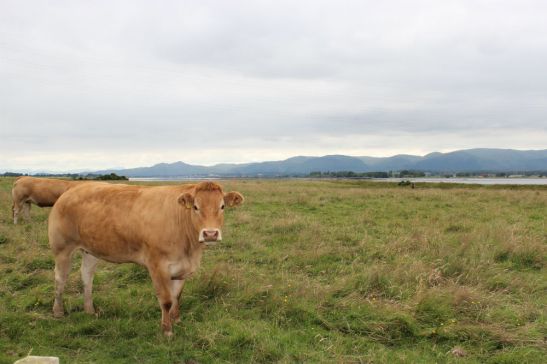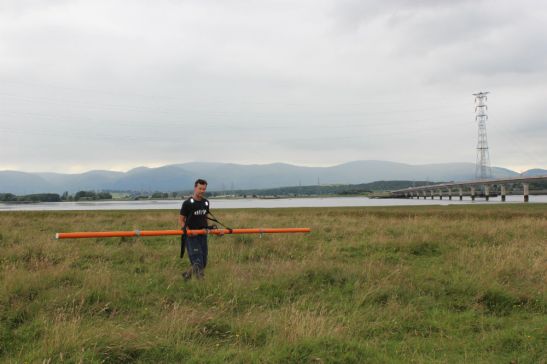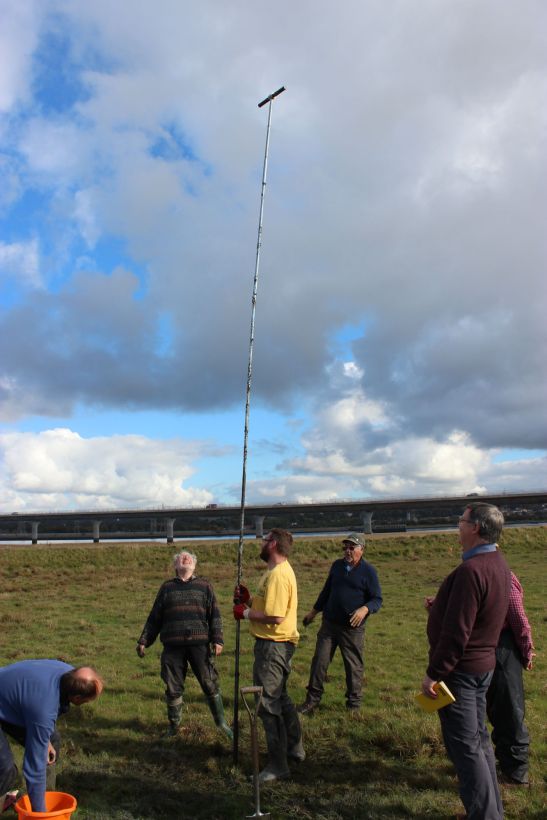Stories from the Scotland's Coastal Heritage at Risk Project
… go to www.scapetrust.org for our current blog
A medieval Royal dockyard at the Clackmannanshire Bridge?
If you crossed the Clackmannanshire Bridge one weekend in early October, you might have seen clusters of people, conspicuous against the green and brown of the salt marsh in yellow, hi-visibility vests. Guided by experts from the Universities of Stirling, Oxford and Coventry, we were embarking on the first stage of investigations that might solve a very long-running mystery. Was Higgins Neuk the site of King James IV’s royal dockyard at Airth? Over the next 2 years, our project will be attempting to find evidence of medieval Higgins Neuk as a contribution to the wider story of the Inner Forth being explored through the Inner Forth Landscape Initiative.
Guided by experts from the Universities of Stirling, Oxford and Coventry, we were embarking on the first stage of investigations that might solve a very long-running mystery. Was Higgins Neuk the site of King James IV’s royal dockyard at Airth? Over the next 2 years, our project will be attempting to find evidence of medieval Higgins Neuk as a contribution to the wider story of the Inner Forth being explored through the Inner Forth Landscape Initiative.
Local historian John Reid first brought this area to our attention. He’s been investigating the history of this part of the river for over 30 years and has made a compelling case to suggest that it could have been the site of a naval dockyard used by James IV from around 1505 to 1512.
Scotland’s Renaissance King was hungry for international prestige, so he invested heavily in the development of a Royal Navy. James founded a dockyard at Newhaven, where the principal ships of his navy were built, and later another docks at the Pow of Airth. Chosen for its location, upstream and more defendable than Newhaven, this was where his flagships were equipped and fitted. The Margaret (named after his Queen, Margaret Tudor) was comparable to the Mary Rose, while the famous Great Michael was the largest and most powerful ship in the world when she was launched in 1511.
John’s extensive historical research suggests that Higgins Neuk, at the mouth of the Pow Burn is the most likely spot for the location of James IV’s royal dockyard at Airth.

Timothy Pont’s late 16th century map showing ships at Airth. This is the only place on the Forth that he drew boats (Reproduced with the permission of the National Library of Scotland).
John has been able to trace an area of land called ‘Docks’ or ‘Doikis’ in the 1500s which, by the 18th century was known as ‘Newmilns’ / ‘Newmill’. This is the name of an estate depicted on the banks of the Pow Burn by General Roy on his map of the 1750s. The mill that it referred to was nearby. Records of 1627 show it belonged to a Patric Hegins, and by the early 18th century, the place becomes known as Heggins-nook. Although this historic place-name fell out of use, it was resurrected recently for the roundabout that was constructed for the new Clackmannanshire Bridge.

General Roy’s Military Survey of Scotland (1747-55), showing the site labelled ‘Newmills’ and ‘Haiggins Neuk’ (Reproduced with the permission of the National Library of Scotland).
Standing on the banks of the Pow, there is nothing on the ground now to suggest either the docks themselves or the hive of activity that would have surrounded them, such as the stables, workshops, accommodation, saw pits and storage warehouses that John’s research has indicated were here 500 years ago.
One of our main challenges is that the Forth in this area now bears little resemblance to the medieval riverscape in which the docks were located. Wholesale drainage of the ‘moss’ or raised bogs upstream from the 1700s onwards led to millions of tonnes of sediment being washed into the Forth dramatically altering the river and the valley. So the first thing we needed to establish was the location of the coast edge in James IV’s time.
To do this, we deployed a range of techniques to help us understand the landscape and to target areas for future trial excavation to have the best chance of finding evidence of the docks or the waterfront infrastructure associated with them.
First, we used geophysics to look under the ground for clues about the buried landscape and potential archaeological features. Historic maps of the area helped us interpret some of the features detected by the geophysical survey. A former loop of the Pow Burn, depicted on 18th and early 19th century maps is easily identified in the geophysics, as is the line of the ‘Old Stone Pier’ mapped in 1828.

Detail from estate plan, Haughs of Airth, 1784, showing the old loop of the Pow Burn and buildings associated with the ferry at Higgins Newek (reproduced with the permission of the national map Library of Scotland).
It’s possible that the mill, which is recorded here only 100 years after the docks were in use, and the later piers and buildings could be on the site of the dockyard – or they might have been built from materials originating from it. This is one theory we will be testing next year.
The geophysics also recorded a semi-circular embayment behind the sea bank and an enigmatic line of blobs running through the field behind the embayment.
To investigate these features and find out more about the evolution of the coastline around Higgins Neuk, environmental scientists and geographers Richard Tipping, Jason Jordan and David Smith introduced us to the auger. In this technique an extendable hollow tube is pushed into the ground to recover a continuous core of sediment.
By examining the sediments it is possible to reconstruct the different environments within which they were laid down.
We were particularly interested in tracing the transition from estuary to salt marsh to dry land, which would help us map the medieval coastline, and in looking for evidence of former channels deep enough to be navigable in the period of James IV’s dockyard.
Further analysis and dating of the cores will build a picture of the landscape 500 years ago and its evolution since. This will help us identify which are the most likely places to search for evidence of James IV’s dockyards.
A further strand of enquiry we pursued was to look for the durable remnants of objects that may have been associated with a dockyard, for example, fragments of metal fixtures and fittings from boats, ships or buildings, nails, broken tools or the lost personal possessions of those who worked here. A team of metal detectorists scoured the fields, and discovered a whopping 234 finds. We carefully recorded the location of all of these finds, and by plotting their distribution on a map will build a picture of potential hotspots of activity. Iron finds are often difficult to identify and very difficult to date. However, some of the detectorists’ finds appear to be boat nails, so watch this space.
A team of metal detectorists scoured the fields, and discovered a whopping 234 finds. We carefully recorded the location of all of these finds, and by plotting their distribution on a map will build a picture of potential hotspots of activity. Iron finds are often difficult to identify and very difficult to date. However, some of the detectorists’ finds appear to be boat nails, so watch this space.
The most unexpected finds were two explosive rockets which had been used in the construction of the nearby pylon. Fortunately, Danny, one of the detectorists was able to identify them, and a specialist bomb disposal team came out to site to safely remove them.

Thanks to the experts from the Royal Logistics Corp Explosive Ordnance Disposal team, our unexpected finds were safely dealt with.
We’re in the process of pulling together all the results of the exploratory techniques used so far, so that in the excavation planned for next year, trenches can be targeted for the best chance of finding evidence of James’ docks.
To find out about the results to date and more about the project in general, come along to Airth Community Hall on Friday 9th December 6.30pm for a round up with mince pies. If you’d like to find out more about the project or sign up to volunteer, please get in touch.











You must be logged in to post a comment.